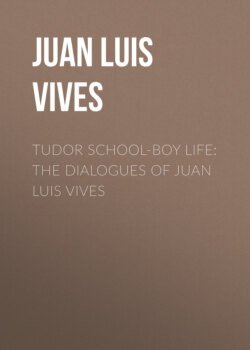Читать книгу Tudor school-boy life: the dialogues of Juan Luis Vives - Juan Luis Vives - Страница 10
Subject-matter and Style
ОглавлениеIn studying a work like the School-boy Dialogues of Juan Luis Vives the modern reader is likely to be attracted much more by the subject-matter than by the literary style of the author. Were the chief interest in Vives’ style, it would be difficult to plead any justification for presenting an English translation. But the fact is that these School Dialogues, in the course of time, have become, as it were, historical documents, serving a purpose which was certainly far from being present in the mind of the author. Vives, no doubt, wished his book to be regarded as good and pure Latinity, and would have been hurt to the quick if he had been charged with the barbarisms and inaccuracies which it was the very object of the book to supplant. But as for the subject-matter, he wanted it to contain the Latin expressions for all sorts of common things which entered into the notice of, and required mention from, the young student of Latin. Vives is thus the forerunner of Comenius, and when he treats of subjects such as clothes, the kitchen, the bed-chamber, dining-room, papers and books, the exterior of the body of man, and supplies the Latin for all the terms used in connection with these subjects, he is exactly on Comenius’s ground in the Janua Linguarum and the Orbis Pictus. But Vives is to be distinguished in two ways from Comenius:—(1) he is constantly in touch with the real interests of boys; (2) he is greatly concerned as to his methods of expression.
It is partly because Vives’ Dialogues are intrinsically attractive that we are content to believe they are a true picture of boys’ manners, habits, and life in the Tudor period. By their realistic sincerity the dialogues bring with them their own evidence of unconscious reality. But furtherxxxiii evidence is to be found in the great success and popularity of the dialogues. For had the details been inaccurate and invraisemblables, and had there been a wrong emphasis of educational spirit, it is not likely that the book would have had its extensive vogue. It must be remembered that there were many competing collections of dialogues. Vives’ Dialogues may therefore be regarded as being amongst the survivals of the fittest. Probably the Latin dialogues for schools which have actually had the widest circulation are those of Erasmus, Maturinus Corderius, and Sébastien Castellion. Of these undoubtedly the dialogues of Vives (1538) and of Corderius (whose dialogues were first published in 1564) throw the most light upon the school-life of boys and the conditions of the schools.
An amiable feature of the School Dialogues of Vives is the introduction, not uncommon in school dialogue-books, of well-known persons, ancient and contemporary, amongst the interlocutors. In this way Vives brings before the boys people like Prince Philip, Vitruvius, Joannes Jocundus Veronensis, and Baptista Albertus Leo, all famous architects (Vitruvius being an author of antiquity, the other two nearer Vives’ time), Pliny, Epictetus, Celsus, Dydimus, Aristippus, Scopas, Polaemon, and personal friends like Valdaura (one of the Bruges family into which Vives married), Honoratus Joannius, Gonzalus Tamayus; the painter Albert Dürer, the scholar Simon Grynaeus, and the poet Caspar Velius, and the great Greek scholar and educationalist Budaeus. Vives delights in devoting one of the dialogues to describe his native town Valencia, and in introducing local references of persons and places there. He also (in Dialogue X.) refers to Antonius Nebrissensis, the first to use Spanish vernacular in connection with Latin text-books. His references to schoolmasters are very numerous, and include manyxxxiv types. They are probably founded upon teachers known to him.
One point further should be mentioned. Vives wishes to supply details in the richest profusion in his various subjects, if for no other reason at least so as to increase the vocabulary of the pupils. Accordingly for his subject-matter he quotes and borrows from many of the old writers. J. T. Freigius, in his Nürnberg edition of 1582, not only names the various ancient authors on technical subjects whom Vives has consulted, but also suggests further reading of authors, whom he might with advantage have also quoted. Looking on the Dialogues as a whole, it is remarkable that so many interests were conciliated, as if by instinct—e.g., the schoolboy, the schoolmaster, the general reader, even in some cases the readers desirous of technical instruction. But the unifying factor was the desire of all those and others to learn to speak Latin, and to know the Latin terms for all useful objects.
